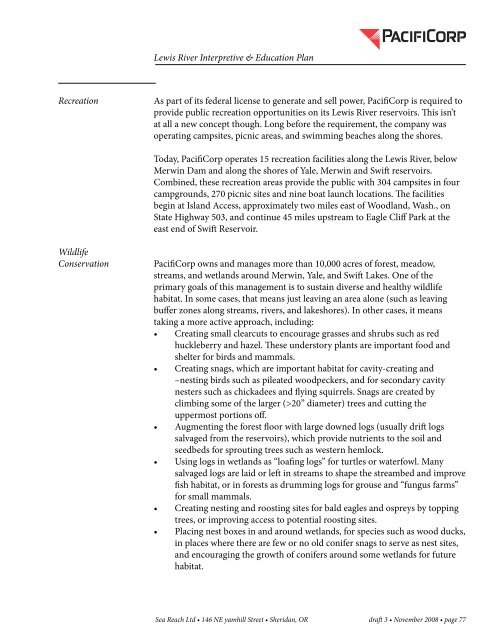The Lewis River Hydroelectric Projects - PacifiCorp
The Lewis River Hydroelectric Projects - PacifiCorp
The Lewis River Hydroelectric Projects - PacifiCorp
You also want an ePaper? Increase the reach of your titles
YUMPU automatically turns print PDFs into web optimized ePapers that Google loves.
<strong>Lewis</strong> <strong>River</strong> Interpretive & Education Plan<br />
Recreation<br />
As part of its federal license to generate and sell power, <strong>PacifiCorp</strong> is required to<br />
provide public recreation opportunities on its <strong>Lewis</strong> <strong>River</strong> reservoirs. This isn’t<br />
at all a new concept though. Long before the requirement, the company was<br />
operating campsites, picnic areas, and swimming beaches along the shores.<br />
Today, <strong>PacifiCorp</strong> operates 15 recreation facilities along the <strong>Lewis</strong> <strong>River</strong>, below<br />
Merwin Dam and along the shores of Yale, Merwin and Swift reservoirs.<br />
Combined, these recreation areas provide the public with 304 campsites in four<br />
campgrounds, 270 picnic sites and nine boat launch locations. <strong>The</strong> facilities<br />
begin at Island Access, approximately two miles east of Woodland, Wash., on<br />
State Highway 503, and continue 45 miles upstream to Eagle Cliff Park at the<br />
east end of Swift Reservoir.<br />
Wildlife<br />
Conservation<br />
<strong>PacifiCorp</strong> owns and manages more than 10,000 acres of forest, meadow,<br />
streams, and wetlands around Merwin, Yale, and Swift Lakes. One of the<br />
primary goals of this management is to sustain diverse and healthy wildlife<br />
habitat. In some cases, that means just leaving an area alone (such as leaving<br />
buffer zones along streams, rivers, and lakeshores). In other cases, it means<br />
taking a more active approach, including:<br />
• Creating small clearcuts to encourage grasses and shrubs such as red<br />
huckleberry and hazel. <strong>The</strong>se understory plants are important food and<br />
shelter for birds and mammals.<br />
• Creating snags, which are important habitat for cavity-creating and<br />
–nesting birds such as pileated woodpeckers, and for secondary cavity<br />
nesters such as chickadees and flying squirrels. Snags are created by<br />
climbing some of the larger (>20” diameter) trees and cutting the<br />
uppermost portions off.<br />
• Augmenting the forest floor with large downed logs (usually drift logs<br />
salvaged from the reservoirs), which provide nutrients to the soil and<br />
seedbeds for sprouting trees such as western hemlock.<br />
• Using logs in wetlands as “loafing logs” for turtles or waterfowl. Many<br />
salvaged logs are laid or left in streams to shape the streambed and improve<br />
fish habitat, or in forests as drumming logs for grouse and “fungus farms”<br />
for small mammals.<br />
• Creating nesting and roosting sites for bald eagles and ospreys by topping<br />
trees, or improving access to potential roosting sites.<br />
• Placing nest boxes in and around wetlands, for species such as wood ducks,<br />
in places where there are few or no old conifer snags to serve as nest sites,<br />
and encouraging the growth of conifers around some wetlands for future<br />
habitat.<br />
Sea Reach Ltd • 146 NE yamhill Street • Sheridan, OR draft 3 • November 2008 • page 77
















